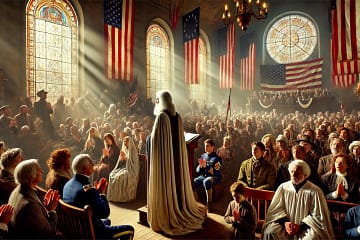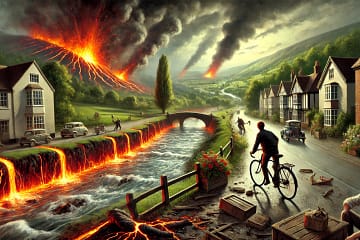“Paradise Lost,” an epic poem by John Milton, was first published in 1667. This masterpiece, written in blank verse, delves into the biblical story of the Fall of Man, exploring themes of rebellion, free will, and redemption. The poem begins with Satan and his fallen angels cast out of Heaven, plotting revenge against God by corrupting His newest creation, mankind.
Comprehensive Plot Summary
In the fiery depths of Hell, Satan, once the most glorious of angels, lies defeated. Cast out of Heaven after rebelling against God, he finds himself in a dismal abyss, where flames provide no light but only illuminate despair. Resolute in his ambition, Satan rouses his legions of fallen angels, stirring their spirits with promises of reclaiming their former glory.
Satan, with his close ally Beelzebub, suggests corrupting God’s new creation—Man—as a means to exact revenge. They assemble a council in Pandemonium, the newly built capital of Hell, where various demons debate their next move. Moloch advocates for open war, while Belial suggests passive submission. Mammon proposes a more subtle approach: seeking solace in Hell and building their empire. Finally, Beelzebub puts forth Satan’s own plan: to seduce and corrupt Man.
Satan volunteers to undertake the perilous journey to the new world. He traverses the chaotic realm of Chaos, encountering the personifications of Sin and Death guarding the gates of Hell. Sin, depicted as a monstrous woman with serpentine features, and Death, a shadowy figure wielding a deadly dart, are revealed to be Satan’s own offspring. With deceitful flattery, he gains passage and eventually reaches the newly created Universe. He ascends to the Sun, where he overhears the Archangel Uriel discussing Earth and Man.
Disguised as a lowly cherub, Satan gains Uriel’s guidance to Earth. Upon arriving, he marvels at the beauty of Paradise and feels a pang of envy and despair. Entering the Garden of Eden, he witnesses Adam and Eve, pure and innocent, enjoying the bliss of God’s favor. Hidden in the shadows, he overhears their conversations and learns of God’s commandment forbidding them to eat from the Tree of Knowledge.
Determined to bring about their downfall, Satan infiltrates Eden in the form of a serpent. He finds Eve alone and begins his temptation, cunningly convincing her that eating the forbidden fruit will grant her divine knowledge and make her like God. Eve, succumbing to curiosity and ambition, eats the fruit and soon persuades Adam to do the same, fearing separation from her.
The immediate effect of their disobedience is a loss of innocence and the dawn of shame and guilt. They cover themselves with fig leaves and experience discord for the first time. The guardian angels, witnessing the Fall, report back to God. The Son of God descends to Earth to pass judgment. He declares that Adam and Eve must leave Paradise but offers them hope for redemption through his future sacrifice.
Sin and Death, sensing the success of Satan’s mission, build a bridge from Hell to Earth, allowing easy access for evil to infiltrate the world. Satan returns to Hell, expecting triumph, only to find his followers transformed into serpents, tormented by their own deceit.
Adam and Eve, now aware of their loss, lament their fate. They realize the gravity of their disobedience and the irreversible consequences it has brought upon them and their descendants. They are comforted by the promise of redemption through the future sacrifice of the Son of God. The Archangel Michael descends to provide them with a vision of the future, revealing mankind’s history and the eventual coming of a Redeemer. Michael shows them scenes of human suffering, wars, and the eventual arrival of Jesus Christ, who will offer salvation to humankind.
Through these visions, Adam gains a deeper understanding of God’s justice and mercy. He learns that despite their fall, humans will have the opportunity for redemption and eternal life through faith and obedience. Comforted by this knowledge, Adam and Eve accept their fate with a renewed sense of purpose. They prepare to leave Eden, acknowledging their responsibility to endure suffering and toil as they seek redemption.
As they depart from Paradise, they are accompanied by a sense of hope and resilience. Adam and Eve, though cast out of Eden, are determined to make the best of their new existence. They understand that their journey will be fraught with challenges, but they are resolved to face them with faith and perseverance.
The story concludes with Adam and Eve walking hand in hand, leaving the gates of Eden behind. They embark on their journey into the world, carrying with them the promise of redemption and the hope of a brighter future. The archangel Michael guides them, ensuring they are not alone in their quest for salvation. The vision of a future where humankind can regain God’s favor provides them with the strength to move forward.
As they step into the unknown, Adam and Eve carry the weight of their transgression but also the promise of redemption. Their journey symbolizes the resilience of the human spirit and the enduring hope for salvation. With each step, they move closer to the fulfillment of God’s plan, confident that through faith and perseverance, they can overcome the trials ahead and achieve eternal life.
Main Characters
- Satan: The rebellious archangel, cast out of Heaven, who becomes the antagonist. His pride and ambition lead him to corrupt mankind as revenge against God.
- Adam: The first man, created by God, whose disobedience results in the Fall. He embodies human curiosity and the capacity for both error and redemption.
- Eve: The first woman, created from Adam’s rib, who succumbs to Satan’s temptation. Her actions underscore themes of free will, innocence, and the quest for knowledge.
- God: The omnipotent creator who foresees the Fall but allows it to unfold to enable redemption through his Son.
- The Son (Jesus Christ): The embodiment of God’s mercy, who sacrifices himself to redeem mankind.
- Beelzebub: Satan’s chief lieutenant, who aids in the planning and execution of the rebellion and subsequent corruption of mankind.
- Michael: The archangel who reveals future events to Adam, offering hope and guidance.
Themes and Motifs
- Rebellion and Obedience: The poem explores the consequences of rebellion against divine authority and the importance of obedience to God’s will.
- Free Will and Predestination: Milton delves into the tension between free will and divine foreknowledge, suggesting that free will is essential for genuine love and faith.
- Good vs. Evil: The epic portrays the cosmic battle between good (God and his angels) and evil (Satan and his followers), emphasizing the moral complexities of these forces.
- Redemption and Sacrifice: Central to the narrative is the promise of redemption through the sacrifice of Jesus, offering hope for humanity’s salvation despite the Fall.
- Knowledge and Ignorance: The pursuit of knowledge leads to mankind’s downfall, raising questions about the nature and limits of human understanding.
Writing Style and Tone
John Milton’s writing style in “Paradise Lost” is grandiose and elevated, characterized by the use of blank verse—unrhymed iambic pentameter. His language is rich and complex, laden with classical references and intricate syntactical structures. Milton employs a vast array of literary devices, including epic similes, allusions, and personifications, to enhance the poem’s grandeur and depth.
The tone of “Paradise Lost” is both solemn and majestic, reflecting the gravity of its themes and the epic nature of its narrative. Milton’s portrayal of the celestial and infernal realms, as well as the profound theological and philosophical questions he raises, imbues the poem with a sense of awe and reverence. His exploration of human frailty and divine justice is both poignant and profound, offering a timeless meditation on the human condition.


